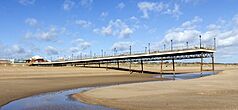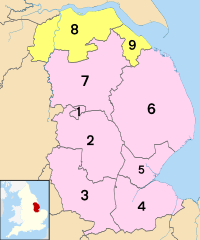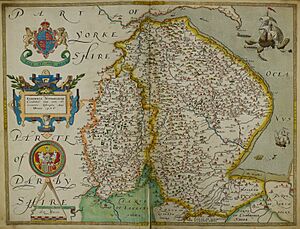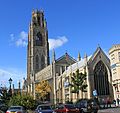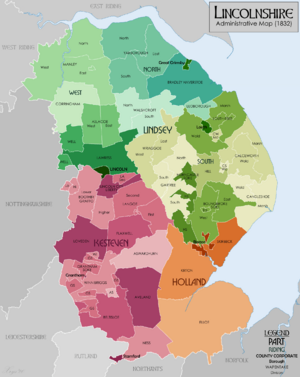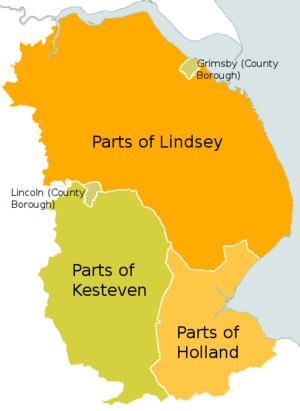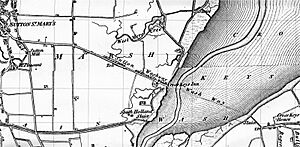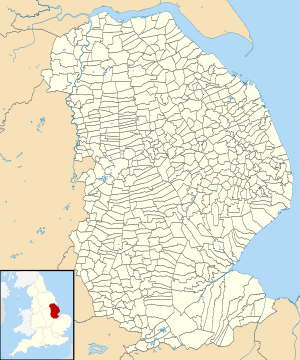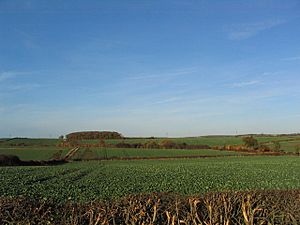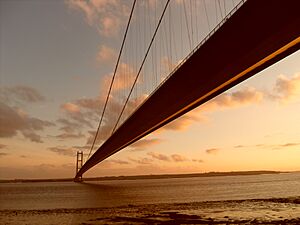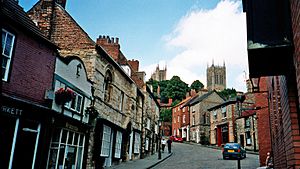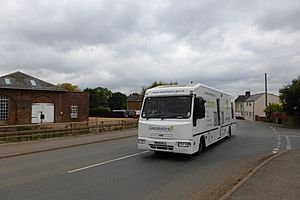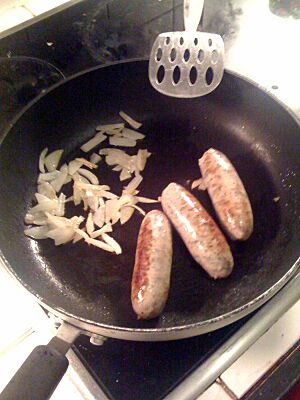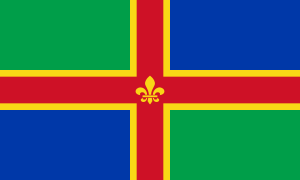Lincolnshire facts for kids
Quick facts for kids
Lincolnshire
|
|||||||||||||||||||||||||||||||||||||||||||||||||||
|---|---|---|---|---|---|---|---|---|---|---|---|---|---|---|---|---|---|---|---|---|---|---|---|---|---|---|---|---|---|---|---|---|---|---|---|---|---|---|---|---|---|---|---|---|---|---|---|---|---|---|---|
|
|
|||||||||||||||||||||||||||||||||||||||||||||||||||
| Motto(s):
"Land and God"
|
|||||||||||||||||||||||||||||||||||||||||||||||||||
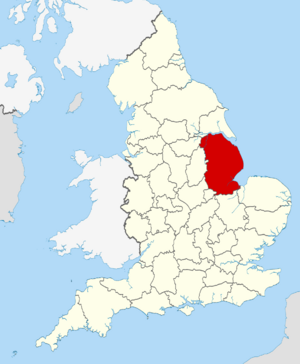
Lincolnshire within England
|
|||||||||||||||||||||||||||||||||||||||||||||||||||
| Sovereign state | United Kingdom | ||||||||||||||||||||||||||||||||||||||||||||||||||
| Constituent country | England | ||||||||||||||||||||||||||||||||||||||||||||||||||
| Region | Divided between East Midlands & Yorkshire and the Humber | ||||||||||||||||||||||||||||||||||||||||||||||||||
| Established | April 1996 | ||||||||||||||||||||||||||||||||||||||||||||||||||
| Established by | 1990s local government reform | ||||||||||||||||||||||||||||||||||||||||||||||||||
| Preceded by | Humberside (North East Lincolnshire & North Lincolnshire) & Lincolnshire (Lincolnshire County Council) | ||||||||||||||||||||||||||||||||||||||||||||||||||
| Origin | Parts of Lincolnshire (Grimsby County Borough, Holland, Kesteven, Lincoln County Borough & Lindsey) | ||||||||||||||||||||||||||||||||||||||||||||||||||
| Time zone | UTC±00:00 (Greenwich Mean Time) | ||||||||||||||||||||||||||||||||||||||||||||||||||
| • Summer (DST) | UTC+01:00 (British Summer Time) | ||||||||||||||||||||||||||||||||||||||||||||||||||
| Members of Parliament | 11 MPs | ||||||||||||||||||||||||||||||||||||||||||||||||||
| Police | Humberside Police (North East Lincolnshire & North Lincolnshire Areas) & Lincolnshire Police (Lincolnshire County Council Area) | ||||||||||||||||||||||||||||||||||||||||||||||||||
|
|||||||||||||||||||||||||||||||||||||||||||||||||||
Lincolnshire (/ˈlɪŋkənʃər, -ʃɪər/), often called Lincs, is a county in England. It is located in the East Midlands and Yorkshire and the Humber regions. Lincolnshire is bordered by the East Riding of Yorkshire to the north and the North Sea to the east. It also shares borders with Norfolk, Cambridgeshire, Northamptonshire, Rutland, Leicestershire, Nottinghamshire, and South Yorkshire. The main city and county town is Lincoln. Lincolnshire is the second largest county in England by area, after North Yorkshire.
This county is mostly rural, meaning it has many farms and open spaces. It covers about 6,959 square kilometers (2,687 sq mi) and has a population of over 1 million people. After Lincoln (with about 104,565 people), the biggest towns are Grimsby (85,911 people) and Scunthorpe (81,286 people). For local government, Lincolnshire has a main county council and two special areas called unitary authorities. These two areas, North Lincolnshire and North East Lincolnshire, are part of the Yorkshire and the Humber region. The rest of the county is in the East Midlands.
Lincolnshire has different types of land. These include the chalk hills of the Lincolnshire Wolds, which are a special natural area. There are also the flat, wet lands called the Lincolnshire Fens, a steep ridge called the Lincoln Cliff, and the Lincolnshire Marsh along the coast.
The county has a calm history, as it was mostly rural and not heavily industrial. In Roman times, Lincoln was an important settlement called Lindum Colonia. Later, in the 5th century, the Angles settled here and formed the Kingdom of Lindsey. Lincoln became a major religious center in 1072, and Lincoln Cathedral was built over many years. The late Middle Ages were a rich time, thanks to the wool trade. This wealth helped build grand churches like St Botolph's Church, Boston. During World War II, Lincolnshire's flat land made it a key location for the Royal Air Force. Many airfields were built, and two bomber squadrons were based there.
Contents
- A Look at Lincolnshire's Past
- Exploring Lincolnshire's Geography
- How Lincolnshire is Governed
- People and Population
- Lincolnshire's Economy
- Getting Around Lincolnshire
- Towns and Villages to Visit
- Tourism and Fun in Lincolnshire
- Lincolnshire's Culture and Traditions
- Media in Lincolnshire
- Military Presence in Lincolnshire
- See also
A Look at Lincolnshire's Past
Before the Romans arrived, most of Lincolnshire was home to the Corieltauvi people. They spoke an old language that is related to modern Welsh. The name Lincoln comes from the Roman name, Lindum Colonia.
After the Romans left, many Germanic people from Europe settled in the region. These people were later called Angles. Because of them, the main language quickly became Old English. However, some communities might have continued to speak the older language until the 8th century.
Modern Lincolnshire was formed by joining the land of the Kingdom of Lindsey with an area controlled by the Danelaw town of Stamford. For a while, the whole county was called "Lindsey." This name is even in the 11th-century Domesday Book. Later, the name Lindsey was used for the northern part around Lincoln. This area became one of the three "Parts of Lincolnshire." The other parts were Holland in the south-east and Kesteven in the south-west. Each part had its own local government.
On February 27, 2008, Lincolnshire had an earthquake. It was one of the largest earthquakes to hit Britain recently.
Lincolnshire is also famous as the birthplace of Sir Isaac Newton. He was born and lived at Woolsthorpe Manor. He went to The King's School, Grantham. You can still see his signature carved into a window sill there from when he was a boy.
Exploring Lincolnshire's Geography
Lincolnshire has a large and varied landscape, with many rivers and rolling countryside. In the north, the county starts near the Isle of Axholme. This is where the Ouse and Trent rivers meet near the Humber. The south side of the Humber estuary forms the border with the East Riding of Yorkshire.
The Humber Bridge crosses the estuary at Barton upon Humber. The southern bank of the Humber Estuary is important for shipping ports like Immingham, New Holland, and Grimsby. From there, the Lincolnshire Coast stretches from Cleethorpes to Mablethorpe and then to Skegness. The coastline then forms the sea boundary with the North Sea and borders Norfolk at The Wash.
Near Boston, the rivers Welland and Haven meet in an area called the "Fosdyke Wash." The sea boundary continues from Fosdyke to the east of Sutton Bridge. Here, a narrow strip of reclaimed land forms the border with Norfolk. Until the early 1800s, there was no land border here. The "Cross Keys Wash" was an area of estuary and marshland where the River Nene flowed into the Wash. It could only be crossed at low tide by a causeway or ferry. This was the natural boundary between the two counties.
The causeway, known as the "Wash Way," was very dangerous. A safer way to get to Norfolk from Lincolnshire was through the Cambridgeshire town of Wisbech. Today, the Cross Keys Bridge at Sutton Bridge is the only direct road link to Norfolk from Lincolnshire over the River Nene.
The border with Cambridgeshire begins at Crowland, Market Deeping, and Stamford. These towns form the southern boundary with Peterborough, Rutland, and a small part of Northamptonshire. Lincolnshire's border with Northamptonshire is only 19 meters (21 yards) long, making it England's shortest county boundary.
From there, the border with Leicestershire and Nottinghamshire starts at Sleaford, Grantham, Lincoln, and Gainsborough. From Gainsborough, the border with South Yorkshire begins at Haxey and Epworth. It then loops back to the north of the county near Scunthorpe, meeting the East Riding of Yorkshire at the Isle of Axholme and Goole.
The rocks under Lincolnshire include limestone (near Lincoln) and chalk (north-east). The area around Woodhall Spa and Kirkby on Bain has a lot of gravel and sand. For much of history, Lincolnshire was under tropical seas. Most fossils found here are from sea creatures without backbones. However, fossils of sea creatures with backbones, like ichthyosaurus and plesiosaur, have also been found.
The highest point in Lincolnshire is Wolds Top, which is 168 meters (551 ft) high. Some parts of the Fens are actually below sea level. The closest mountains are in Derbyshire.
The biggest rivers in Lincolnshire are the Trent and the Witham. The Trent flows north along the western edge of the county to the Humber estuary. The Witham starts in Lincolnshire and flows 132 km (82 miles) through the middle of the county. It eventually empties into the North Sea at The Wash. The Humber estuary, on Lincolnshire's northern border, also gets water from the River Ouse. The Wash is also where the Welland, Nene, and Great Ouse rivers meet the sea.
Lincolnshire's geography has several distinct areas:
- Lincolnshire Wolds: Rolling hills in the north-east, a protected natural area.
- The Fens: Flat, low-lying wetlands in the south-east.
- The Marshes: Coastal areas along the county's edge.
- Lincoln Edge or Cliff: A limestone ridge running north-south in the western half.
Lincolnshire has important nature reserves. These include Gibraltar Point National Nature Reserve, Whisby Nature Park, Donna Nook National Nature Reserve, RSPB Frampton Marsh, and the Humberhead Peatlands National Nature Reserve. Even though much of the county is farmed, there are many areas with diverse wildlife, especially wetlands and rare limewood forests. A long time ago, much of the county was wet fenland.
From old bones, we know that animals like woolly mammoth, woolly rhinoceros, wild horse, wolf, wild boar, and beaver once lived in Lincolnshire. Some animals have recently returned to the county after disappearing, such as the little egret, Eurasian spoonbill, European otter, and red kite.
How Lincolnshire is Governed
Local Government in Lincolnshire
After the 2024 general election, Lincolnshire is represented by ten Members of Parliament (MPs). These MPs represent areas entirely within the county. Small parts of Lincolnshire are also included in constituencies with neighboring counties.
The Lincolnshire County Council is mostly controlled by the Conservative Party. It has 54 Conservative councillors, along with councillors from other parties and independent members. The county also has seven local borough and district councils, plus two unitary authority areas. These unitary authorities, North Lincolnshire and North East Lincolnshire, are independent of the county council.
The City of Lincoln Council is controlled by the Labour Party. North Kesteven, South Holland, and East Lindsey are run by the Conservatives. South Kesteven is controlled by a group of independent, Labour, Green, and Liberal Democrat councillors. West Lindsey is controlled by a group of Liberal Democrats and independents. The Borough of Boston is controlled by the local Boston Independent party.
People and Population
The tables below show the ethnic and religious makeup of Lincolnshire in 2021:
| White | Asian | Black | Mixed and other |
|---|---|---|---|
| 96% | 2% | 1% | 1% |
| Christianity | Islam | Other | No religion |
|---|---|---|---|
| 52.2% | 1.1% | 7.2% | 39.5% |
Lincolnshire's Economy
| Year | County-wide | Agriculture | Industry | Services |
|---|---|---|---|---|
| 1995 | 5,719 | 657 | 1,769 | 3,292 |
| 2000 | 6,512 | 452 | 2,046 | 4,013 |
| 2003 | 8,419 | 518 | 2,518 | 5,383 |
- includes hunting and forestry
- includes energy and construction
- includes financial intermediation services indirectly measured
Some well-known businesses in Lincolnshire include the Lincs FM Group, Young's Seafood, Openfield, and the Lincolnshire Co-operative. About a quarter of the county's population are members of the Lincolnshire Co-operative.
Farming in Lincolnshire
Lincolnshire has always been a major farming area. Farmers here grow large amounts of wheat, barley, sugar beet, and oilseed rape. In south Lincolnshire, where the soil is very rich, common crops include potatoes, cabbages, cauliflowers, and onions. Farmers in Lincolnshire often set world records for how much crop they can grow.
South Lincolnshire is also home to a leading agricultural experiment station in the UK. It is located in Sutton Bridge and run by the Potato Council. This station does research for the British potato industry.
The Lincoln Longwool is a rare type of sheep named after the region. It was developed over 500 years ago for both its wool and meat. It has the longest fleece of any sheep breed. The Lincoln Red is an old type of beef cattle that also comes from the county. In the mid-20th century, many farms in Lincolnshire stopped raising different animals and focused only on growing crops. This was partly because wool imports became cheaper and because the drier land in eastern England is good for growing crops.
Around 1900, new machines greatly reduced the number of workers needed on farms. Because of this, fewer people worked in farming. Several engineering companies grew in Lincoln, Gainsborough, and Grantham to support these changes. One of these was Fosters of Lincoln, which built the first tank. Another was Richard Hornsby & Sons of Grantham. Most of these industrial companies closed down in the late 20th century.
Today, many seasonal farm workers come from other countries, especially from Central and Eastern Europe. They help with crops that need more hand labor, like small vegetables and cut flowers. This seasonal arrival of workers sometimes causes small disagreements between the workers and local people. Agricultural training is available at Riseholme College. In 2016, the University of Lincoln opened the Lincoln Institute for Agri-Food Technology.
Services and Shopping
A study in 2000 ranked the town centers in Lincolnshire by their size. The largest were:
- Lincoln
- Grantham
- Grimsby
- Boston and Scunthorpe (equal)
- Spalding
- Stamford
- Skegness
- Louth
- Sleaford
- Gainsborough
- Brigg
- Cleethorpes
- Bourne
- Horncastle and Mablethorpe (equal)
Getting Around Lincolnshire
Lincolnshire's transport links are not as developed as in some other parts of the UK. This is because it is on the edge of England's main economic areas. The roads are mostly single carriageway "A roads" and local "B roads." There are very few motorways or dual carriageways. Lincolnshire is one of the few UK counties without a motorway. Until recently, there were only about 35 km (22 miles) of dual carriageway in the whole county. The M180 motorway goes through North Lincolnshire. The A46 is now a dual carriageway between Newark-on-Trent and Lincoln.
Because the county has a low population density, there are not many railway stations or train services. Many railway stations closed after the Beeching Report in 1963. One notable line between Lincoln and Sleaford reopened soon after it closed. Most other closed lines were removed long ago, and the land is now used for farming.
Before 1970, a direct train service ran between Cleethorpes and London King's Cross. This route went through Louth, Boston, and Peterborough. Part of this old line in Grimsby is now the A16 road, so it cannot be a railway again. A small part of the line is now the Lincolnshire Wolds Railway.
A daily direct train service ran between Cleethorpes and London King's Cross until the late 1980s. This service went through Grimsby, Market Rasen, and Lincoln Central. It was stopped after the main East Coast railway line was electrified. Now, passengers usually have to change trains at Newark North Gate to travel to and from London. However, the East Coast Main Line goes through the western edge of the county. You can catch direct trains to London from Grantham.
Most train services are currently run by East Midlands Railway and Northern Trains. London North Eastern Railway (LNER) and CrossCountry also have services that pass through the county. LNER trains often stop at Grantham on the East Coast Main Line. They also have a service to Lincoln every two hours. CrossCountry trains stop at Stamford on their way between Birmingham and Stansted Airport. Stations along the Humber are served by TransPennine Express services between Manchester Airport and Cleethorpes. One of the least frequent train services in the UK is in Lincolnshire. The Sheffield-Gainsborough Central-Cleethorpes line only has passenger trains on Saturdays, with three trains in each direction. This line is mainly used for freight.
On May 22, 2011, East Coast started a Lincoln-London service. It began with one train a day each way. This increased in 2019 to a service every two hours. East Midlands Railway also runs a daily service (Monday-Saturday) between Lincoln and London St Pancras. This is a stopping service that takes about three hours via Nottingham. LNER's service to London King's Cross takes about 1 hour 50 minutes.
The only airport in Lincolnshire is Humberside Airport, near Brigg. East Midlands Airport, the main airport for the East Midlands, is also reachable from the county. Until it closed in 2022, Doncaster Sheffield Airport was also within reach of much of Lincolnshire.
The county's biggest bus companies are Stagecoach Grimsby-Cleethorpes and Stagecoach in Lincolnshire. There are also several smaller bus companies. A Sustrans cycle route runs from Lincoln to Boston in the south of the county.
Towns and Villages to Visit
Here are the 12 largest towns and villages in Lincolnshire by population:
- Lincoln (Population: 104,565)
- Grimsby (Population: 85,911)
- Scunthorpe (Population: 81,286)
- Boston (Population: 45,339)
- Grantham (Population: 44,898)
- Spalding (Population: 30,556)
- Cleethorpes (Population: 29,678)
- Gainsborough (Population: 21,908)
- Stamford (Population: 20,742)
- Skegness (Population: 20,704)
- Sleaford (Population: 18,033)
- Bourne (Population, 17,490)
A small part of the Thorne Waste area of Thorne in South Yorkshire is currently part of North Lincolnshire.
Tourism and Fun in Lincolnshire
Most tourism in Lincolnshire happens along the coast, east of the Lincolnshire Wolds. The county has some very well-known seaside resorts in the UK. These attract many visitors, especially from the East Midlands and parts of Yorkshire. There are three main coastal resorts and several smaller village resorts.
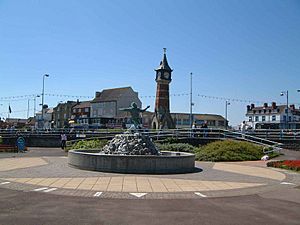
The main seaside resort is Skegness, famous for its Jolly Fisherman mascot and slogan "Skegness is so bracing." Its nearby village resorts, Ingoldmells and Chapel St Leonards, have many large caravan and holiday sites. Skegness offers amusements, beaches, and shops. It is also home to Butlins Skegness, Fantasy Island, Church Farm Museum, Natureland Seal Sanctuary, Skegness Stadium, Skegness Pier, and several golf courses. It has good road, bus, and rail links.
The second largest group of resorts is the seaside town of Mablethorpe, known for its golden sands. Nearby are the village resorts of Trusthorpe and Sutton-on-Sea. This area also has leisure activities and large holiday sites. It is less developed, with fewer arcades and nightclubs, and poorer road links. However, it offers a more traditional seaside experience.
The third group includes the seaside town of Cleethorpes and the large village resort of Humberston. It has the Cleethorpes Coast Light Railway and Cleethorpes Pier, plus local golf courses and holiday sites. Cleethorpes is easy to reach by road and rail, being close to the M180 and on the TransPennine Express route to Manchester.
Nature is a big draw for tourists. The south-east of the county is fenland, which attracts many bird species. The national nature reserves at Gibraltar Point, Saltfleetby-Theddlethorpe, and Donna Nook are also popular. Donna Nook has a large grey seal colony that visitors love to see.
The market towns of the Lincolnshire Wolds, like Louth, Alford, Horncastle, Caistor, and Spilsby, are also attractive. Several have important historic buildings, such as Alford Manor House, St James' Church, and Bolingbroke Castle. The Wolds are popular for cycling and walking, with events like the Lincolnshire Wolds Walking Festival.
The city of Lincoln has many tourist attractions. These include Lincoln Castle, Lincoln Cathedral, The Engine Shed, Steep Hill, International Bomber Command Centre, and Guildhall and Stonebow. The city is a major tourist center in the East Midlands.
Lincolnshire's Culture and Traditions
Lincolnshire has a very rural culture. Because towns are far apart, many villages have kept their own shops, pubs, halls, and churches. These offer many social activities for local people. Fishing in the rivers and drains of the fens, and shooting, are popular activities. Much of Lincoln's culture is based on its history. The Collection is an archaeological museum and art gallery in Lincoln. Lincoln Cathedral is also a big part of Lincoln's culture, hosting concerts and food markets throughout the year.
An old Lincolnshire tradition was that front doors were only used for three things: a new baby, a bride, and a coffin.
People of Lincolnshire
People born in Lincolnshire are sometimes called "Yellowbellies" (or "Yeller Bellies"). The reason for this nickname is debated. The most common belief is that it comes from the uniform of the 10th Regiment of Foot (later the Lincolnshire Regiment), which had yellow parts. Because of this, the coat of arms of Lincolnshire County Council has two officers from the regiment supporting it.
Local Way of Speaking
Like many other dialects in the North and Midlands of England, people in Lincolnshire often say "flat" a. For example, "bath" sounds like /bæθ/ instead of /bɑːθ/. Also, "water" was traditionally pronounced "watter," though this is rare now. Similarly, the "uh" sound is often replaced by "oo."
Some features more specific to Lincolnshire include:
- Making the "ay" or "ee" sound into a longer "air" or "yair" sound. For example, "mate" might sound like "myairt" and "beast" like "byairst."
- Making the "oh" sound into "ooa." For example, "boat" might sound like "booat."
- Adding an extra "uh" sound into words like "now."
- Words used: "duck" as a friendly way to address someone, "mardy" meaning upset or angry, "mowt" for "might," "while" instead of "until," "frit" meaning frightened, "grufty" meaning dirty or disgusting, and the greeting "now then!?" (hello).
Lincolnshire has its own dialect "champion," a farmer named Farmer Wink (Robert Carlton). He makes videos about rural life, spoken in his strong Lincolnshire accent. Someone from Woodhall Spa has even published a dictionary of old words used in the county.
Music from Lincolnshire
"The Lincolnshire Poacher" is a famous folk song and almost the county's unofficial anthem. It tells the story of someone poaching at night. It was the marching song of the 10th Regiment of Foot, who were known as "the Poachers."
Historically, Lincolnshire was known for its Lincolnshire bagpipes. These instruments were thought to be rough and unpleasant, but they were very popular in the county. The last player died in 1851, and the instrument has not been played since.
The Australian composer Percy Grainger made some of the first recordings of British folk songs in Lincolnshire between 1906 and 1908. He used a wax Phonograph Cylinder. These recordings are now kept in the British Library. They include songs sung by Joseph Taylor, who became the first folk singer to be recorded for sale. His song "Brigg Fair" inspired classical music by Grainger and Frederick Delius. In 1937, Grainger wrote his Lincolnshire Posy for a wind band. This piece is a collection of folk songs he gathered in Lincolnshire. Ralph Vaughan Williams often visited Gunby Hall, and his collected folk song "Daffodils" is in their collection.
Several composers have lived and worked in the county. William Byrd was an organist at Lincoln Cathedral from 1563 to 1572. John Taverner was a singer at Tattershall Collegiate Church in 1525 and also sang at St Botolph's Church, Boston. He is thought to be buried under its famous "stump." Thomas Linley, a composer and friend of Mozart, drowned in the lake at Grimsthorpe Castle near Bourne in 1778. Nicholas Maw was born in Grantham, and Peter Seabourne lives in East Kirkby.
Delicious Lincolnshire Food
Lincolnshire has several local dishes:
- Stuffed chine – This is a salted cut of pork from the neck, cured for up to ten months. It is stuffed with parsley (other ingredients are usually secret) and served cold.
- Haslet – A type of pork loaf, also flavored with sage.
- Lincolnshire sausages – Most butchers in Lincolnshire have their own secret recipes. A competition is held each year to find the best sausages in the county. Traditional Lincolnshire sausages are made from minced pork, stale bread crumbs (nowadays rusk), pepper, sage, and salt. They use natural casings made from sheep or pig intestines.
- Pork pies – Pork butchers are also proud of their unique pork pie recipes.
- Giblet pie.
- Lamb and mutton stuffed with oysters.
- Plum bread – Like plum pudding, "plum" here means dried fruit like currants, raisins, and sultanas, sometimes soaked in tea.
- Grantham Gingerbread – A hard, white ginger biscuit.
- Lincolnshire Poacher cheese – A cheddar-style cheese made in Alford. It has won many awards, including Supreme Champion at the 1996/7 British Cheese Awards.
- Batemans ales – A beer brewed in Wainfleet and served in many pubs.
- There are also several small breweries.
- Grimsby is known for its fishing industry. Historically, Grimsby Fish was very valuable. After the fishing industry declined in the 1970s, most fish sold at the town's market now comes from other ports. However, Grimsby Fish is still a recognized product. In 2009, smoked fish from the town received special protection from the European Union. This recognized the unique smoking methods used by local fish companies.
- Craft chocolatiers can be found across the county, such as Hansens in Folkingham. In 2013, Redstar Chocolate's Duffy's Venezuela Ocumare Milk won a gold medal for best bean-to-bar chocolate. The factory is in Cleethorpes.
Events and Festivals
Every year, the Lincolnshire Agricultural Society, founded in 1869, holds the Lincolnshire Agricultural Show. It takes place on a Wednesday and Thursday in late June at its showground north of Lincoln. The show first happened here in 1958. It is one of the largest agricultural shows in the country, with about 100,000 visitors over two days. The showground is also used for many other events throughout the year.
Smaller local agricultural shows, like the Heckington Show, are still held. The Corby Glen sheep fair has been held since 1238.
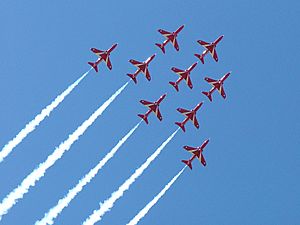
Each year, RAF Waddington hosts the RAF International Waddington Air Show. This two-day event attracts about 150,000 people, usually in early July. Over 35 countries have taken part, with aircraft from around the world. Starting in 2017, the event moved to nearby RAF Scampton.
On the Monday before Easter, a unique auction happens in Bourne. It is for the grazing rights of the Whitebread Meadow. Bidding happens while two boys race towards the Queen's Bridge. The end of their race marks the end of the bidding. This tradition dates back to William Clay's will in 1742.
The Haxey Hood village competition takes place every January, and has for over 700 years.
Stamford's Mid-Lent fair brings showmen to the town the week after Mothering Sunday. Rides and side shows fill Broad Street, the Sheepmarket, and the Meadows for a week. Stalls selling Grantham gingerbread and nougat are a traditional part of the fair. The following week, the fair moves to Grantham.
The villages of Tetford and Salmonby hold an annual Scarecrow Festival every May.
The Belchford Downhill Challenge happens every two years. Soapbox racers speed down a hill at up to 30 km/h (19 mph). Up to 1,000 people have attended this event.
The Lincoln Christmas Market was a street market held in the historic part of the city in early December. It was one of the largest Christmas markets in Europe, attracting over 250,000 people over four days. Around the same time, Christmas lights are turned on in Bourne, Sleaford, Skegness, and other towns.
Throughout the summer, the Stamford Shakespeare Company performs Shakespeare's plays outdoors at Tolethorpe Hall, which is actually in Rutland.
The Spalding Flower Parade was held every late spring from 1959 to 2013. Colorful floats decorated with tulip heads competed for a cup.
Sports in Lincolnshire

The main sports played in Lincolnshire are football, cricket, and rugby union. Lincolnshire does not have a very high sporting profile, mainly because there are not many large sports facilities or top-level football teams. The most famous sporting venues are Cadwell Park near Louth, which hosts a round of the British Motorbike Championship, and the racecourse at Market Rasen.
- Two football teams from Lincolnshire play in the Football League: Lincoln City in League One and Grimsby Town in League Two. In non-league football, Scunthorpe United and Boston United play in the National League North. Gainsborough Trinity plays in the Northern Premier League. When any of these clubs play each other, it's called a Lincolnshire derby. The most well-known derby is between Lincoln City and Grimsby Town.
- In cricket, Lincolnshire is a minor county team and plays in the Minor Counties Championship.
- In hockey, Lindum Hockey Club plays in northern Lincoln.
- Scunthorpe Rugby Club is the most notable rugby union team from Lincolnshire. Other teams include Market Rasen and Louth RUFC, Lincoln RFC, and Boston RFC.
- Lincolnshire has one racecourse, at Market Rasen.
- Cadwell Park is the only motor-racing course in Lincolnshire. There is a speedway track in Scunthorpe, home of the Scunthorpe Scorpions. There is also stock-car racing at a stadium in Orby, near Skegness.
- Lincolnshire has an American Football club, the Lincolnshire Bombers, which started in its current form in 2005.
- Lincolnshire is home to the UK roller derby team, the Lincolnshire Bombers Roller Girls.
- Lincolnshire is home to Lincolnshire Lions Rugby League, which has an Open Age Men's team playing in the Midlands Merit League since 2022.
Symbols of Lincolnshire
The unofficial song of the county is the traditional folk song, "The Lincolnshire Poacher." It dates from around 1776. A version of the song was the theme for BBC Radio Lincolnshire for many years.
The county flower of Lincolnshire is the common dog-violet. This was chosen in a 2002 campaign by the charity Plantlife.
In August 2005, BBC Radio Lincolnshire and Lincolnshire Life magazine asked people to vote for a flag of Lincolnshire to represent the county. Six designs were voted on, and the winning design was revealed in October 2005. Lincoln city has its own flag, which is St George's flag with a Fleur-de-Lys.
The Lincoln Imp has been a symbol for the cathedral, city, and county for many years. In 2006, it was replaced as the brand for Lincolnshire County Council by a new, simpler design.
Media in Lincolnshire
Newspapers
The county has one daily newspaper, the Grimsby Telegraph. It is published in Grimsby and covers North East Lincolnshire, reaching as far south as Louth and Alford and as far west as Brigg.
There are two other weekly papers that used to be daily until 2011. The Lincolnshire Echo is published weekly from Lincoln and covers most of the county, reaching north to Louth. The Scunthorpe Telegraph covers northern Lincolnshire. All three are owned by Reach plc.
There are also several weekly papers for individual towns, published by Iliffe Media. One of these, the Stamford Mercury, claims to be Britain's oldest newspaper. However, it is now a typical local weekly and no longer covers stories from the whole East Midlands as it once did.
Television
Most of Lincolnshire gets its TV signals from the Belmont transmitter. This means it receives programs from ITV Yorkshire and BBC One Yorkshire and Lincolnshire regions.
Since 2003, the BBC has provided a local news service for the area called "Look North." It is broadcast from Hull, with input from studios in Lincoln and Grimsby.
ITV Yorkshire provides coverage through its evening news program "Calendar." Until late 2008, there was a separate version for the Belmont transmitter. From January 2009, the program covers the entire ITV Yorkshire region.
From 1959 to July 1974, ITV programs were provided by Anglia Television. This company had news offices in Grimsby. After a transmitter change, ITV services were provided by Yorkshire Television. This company kept the Grimsby offices open and added facilities in Lincoln, but both closed in the mid-1990s.
- South-west Lincolnshire receives BBC East Midlands and ITV Central. These are broadcast from the Waltham-on-the-Wolds Transmitting Station. A small number of homes in the very south of the county can also receive regional programming from BBC East and ITV Anglia.
Many villages west of the Lincoln Edge cannot get a signal from Belmont due to hills blocking it. Instead, they get their TV from Emley Moor near Huddersfield.
Radio
The area is covered by several local radio stations:
BBC Local Radio
- BBC Radio Lincolnshire can be heard throughout historic Lincolnshire.
- BBC Radio Humberside covers the northern parts of Lincolnshire that were once South Humberside.
- BBC Radio Cambridgeshire can be heard in southern Lincolnshire.
- BBC Radio Norfolk can be heard around east Lincolnshire.
- BBC Radio Leicester can be heard in south-west Lincolnshire.
- BBC Radio Nottingham can be heard in west Lincolnshire.
- BBC Radio Northampton can be heard in Stamford.
Independent Local Radio
- Greatest Hits Radio Lincolnshire covers historic Lincolnshire.
- Greatest Hits Radio Peterborough, Stamford and Rutland covers Stamford.
- Heart East covers Peterborough and South Lincolnshire.
- Hits Radio East Yorkshire & North Lincolnshire covers Northern Lincolnshire and East Yorkshire.
- Hits Radio Lincolnshire covers historic Lincolnshire.
- Capital East Midlands covers West Lincolnshire on 105.4 and 96.2 FM.
- Capital Yorkshire covers Northern Lincolnshire and East Riding Of Yorkshire.
- Smooth East Midlands covers West, Central, and South East Lincolnshire on 106.6 FM, and South Lincolnshire on 106.8 FM.
Community radio
- Siren Radio Lincoln (now closed).
- Endeavour Radio Boston.
- TMCR 95.3 (covering Epworth and Isle of Axholme).
- Tulip Radio Spalding and South Holland (Closed).
- Mansfield 103.2 (Community Station for Mansfield but reaches Lincoln).
- LCR 103.6 (Community Station for Lincoln but reaches Central Lincolnshire).
Military Presence in Lincolnshire
Air Force
Lincolnshire's flat land and low population make it perfect for airfields. The Air Ministry built many bases here, and the county became known as "bomber county." After World War II, most of these airfields closed. However, the RAF still has a strong presence in Lincolnshire for UK air defense and pilot training. For more information on former bases, see List of former RAF stations.
Two important active bases in Lincolnshire are RAF Coningsby and RAF Waddington. RAF Coningsby is one of only two Quick Reaction Alert (QRA) Stations in the UK, home to Eurofighter Typhoon jet fighters. RAF Waddington is where most of the RAF's Intelligence, Surveillance, Target Acquisition, and Reconnaissance aircraft are based. The Red Arrows Aerobatic Team has also been based at Waddington since October 2022. Other stations include RAF Cranwell, where all Air Force Basic Officer Training happens. RAF Barkston Heath is a training airfield. There are also smaller bases like RAF Donna Nook and RAF Digby.
Lincolnshire also has two active RAF and NATO air weapons training bombing ranges. They are located along The Wash and the north Lincolnshire coastline. These are RAF Holbeach, active since 1926, and Donna Nook. The RAF Wainfleet range closed in 2010.
Army
The Army has Sobraon Barracks, home to 160 (Lincoln) Squadron, Royal Logistic Corps (RLC). It also has Prince William of Gloucester Barracks in Grantham, which houses national specialist logistics units. In November 2016, the Ministry of Defence announced that the Grantham site would close in 2020. This date has been extended twice, most recently to 2028.
See also
 In Spanish: Lincolnshire para niños
In Spanish: Lincolnshire para niños




